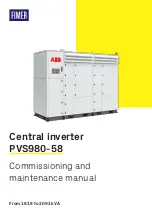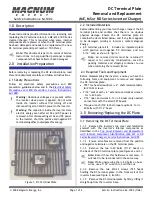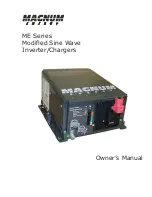
11R
To avoid overloading your Inverter/Charger, match the power requirements of the equipment you plan to run at any one time (add their total
watts) with the output wattage capacity of your Inverter/Charger model (see Specifications). Do not confuse “continuous” wattage with
“peak” wattage ratings. Most electric motors require extra power at start-up (“peak wattage”) than required to run continuously after start-
up, sometimes over 100% more. Some motors, such as in refrigerators and pumps, start and stop intermittently according to demand,
requiring “peak wattage” at multiple, unpredictable times during operation. DoubleBoost
™
Feature: Tripp Lite Inverter/Chargers deliver up
to twice their nameplate rated wattage for up to 10 seconds,* providing the extra power needed to cold start heavy-duty tools and equipment.
OverPower
™
Feature: Tripp Lite Inverter/Chargers deliver up to 150% of their name-plate rated wattage for up to 1 hour,* providing plenty
of reserve power to reliably support tools and equipment longer.
* Actual duration depends on model, battery age, battery charge level and ambient temperature.
Warning! Consult a qualified electrician and follow all applicable electrical codes and requirements for
hardwire connection. Disconnect both DC input and AC utility supply before attempting hardwiring. Use wire
type THHN or equivalent with minimum temperature rating of 90°C.
Connection for Models with Hardwire Terminals
Output Connection Requirement: UL requires that the output terminals of all hard-
wire Inverter/Charger models must be connected to UL-listed GFCI receptacles
(required receptacle manufacturer/model series: Hubbell GF8300 or
Leviton 6598).
Single Input/Output Models
Input:
Connect incoming wires to the hot (brown) , neutral (blue)
and ground* (green) terminals .
Output:
Connect outgoing wires to the hot (black)
, neutral (white)
and ground* (green) terminals .
Replace cover plate and tighten screws.* If the incoming conduit only contains two wires (hot and neutral), the incoming conduit must be bonded to the main ground lug on the unit. In any case,
the incoming conduit must be bonded to earth or vehicle ground, and the incoming conduit must be bonded to the outgoing conduit.
1
2
3
4
5
AC Input/Output Connection
HOT IN
NEUTRAL IN
GROUND IN
GROUND OUT
HOT OUT
“FOR USE WITH COPPER WIRE ONLY”
NEUTRAL OUT
2
3
1
4
5
Note: Ground Bond Connection, Supplied
1
Service
Before returning your Inverter/Charger for service, follow these steps: 1.) Review the installation and operation instructions to ensure that
the service problem does not originate from a misreading of the instructions. Also, check that the circuit breaker(s) are not tripped.* 2.) If
the problem continues, do not contact or return the Inverter/Charger to the dealer. Instead, call Tripp Lite at (773) 869-1233. A service
technician will ask for the Inverter/Charger’s model number, serial number and purchase date and will attempt to correct the problem over
the phone. 3.) If the problem requires service, the technician will issue you a Returned Material Authorization (RMA) number, which is
required for service. Securely pack the Inverter/Charger to avoid damage during shipping. Do not use Styrofoam beads for packaging.**
Any damages (direct, indirect, special, incidental or consequential) to the Inverter/Charger incurred during shipment to Tripp Lite or an
authorized Tripp Lite service center is not covered under warranty. Inverter/Chargers shipped to Tripp Lite or an authorized Tripp Lite
service center must have transportation charges prepaid. Mark the RMA number on the outside of the package. If the Inverter/Charger is
within the warranty period, enclose a copy of your sales receipt. Return the Inverter/Charger for service using an insured carrier to the
address given to you by the Tripp Lite service technician.
* This is a common cause of service inquiries which can be easily remedied by following the resetting instructions in this manual. ** If you require packaging, the technician can arrange to send you proper packaging.
Your Inverter/Charger requires no maintenance and contains no user-serviceable or replaceable parts, but should be kept dry at all times.
Periodically check, clean and tighten all cable connections, as necessary, both at the unit and at the battery.
Maintenance































